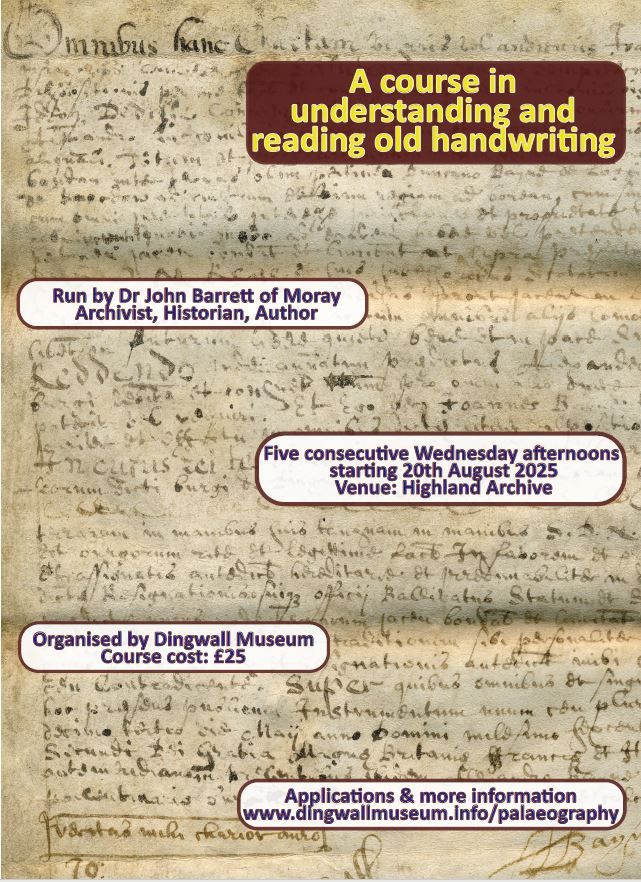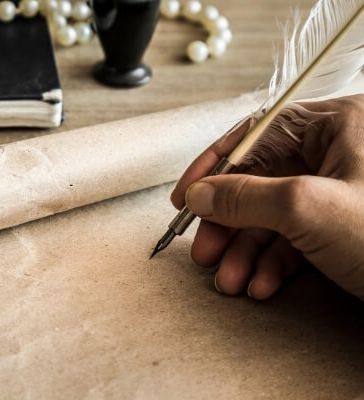
Palaeography is the study of old handwriting. It involves deciphering and understanding historical manuscripts, documents, and inscriptions, helping to date and interpret them.
A course run by Dr John Barrett, historian, archivist and palaeograhy expert
Location: Highland Archive, Inverness. Location here
The five-week course runs on consecutive Wednesday afternoons, starting 20th August. and finishing 17th September. 1400-1645hrs
THE COURSE IS NOW FULL. However, do contact us if you'd like to go on the waiting list.
Course Outline
All historians need to be able to read old handwriting. Unfortunately the unfamiliar handwriting styles of historical documents can hamper the efforts of local historians. But with a little expert help and a lot of practice the old handwriting of archival documents will cease to be a bewilderment. This short course of accessible workshops will introduce the variety and evolution of handwriting styles through a sequence of hands-on workshops. The usual handwriting of Scottish archives will be examined and explained. Practical exercises will enable participants to read, understand and transcribe the handwriting styles most commonly encountered in the study of Scottish local history.
The course will be conducted by John Barrett, who is a professional archivist. The course will take the form of five seminar/workshops for a small group of 5-10 participants. No previous experience of palaeography is required. Participants will work together to transcribe one or two documents in each weekly session lasting a full afternoon (2-3 hours including breaks for tea and biscuits). A homework exercise will form the basis of each session.
We will be working, perforce, from photocopies; though a few original documents may be available.
Participants will find it useful to bring along a pad of paper and a pencil. (Archivists do not look kindly on the use of pens and ink.) A clear plastic ruler may be useful for following the line of script. A magnifying glass may also help
Outline programme
Session 1
The first session will begin with a brief chalk-and-talk introduction. This will outline the invention and evolution of handwriting – from hieroglyphs to runes.
A short overview of insular scripts will introduce varieties of Roman writing, the Gaelic gospel-book scripts and Anglo-Saxon minuscule. This will serve as a preface to the administrative, legal and literary hands of the middle ages (from Domesday Book to the fifteenth century). Three or four medieval documents will be considered in detail to show the evolution of handwriting styles towards the Secretary hand of the sixteenth century. This is the usual handwriting of early-modern administrative and legal documents – and the script most likely to cause difficulty to students of local history.
Session 2-5
These sessions will discuss and transcribe documents from the early modern period. During four sessions participants will work backwards from the relatively straightforward handwriting of the early eighteenth century towards thye more troublesome secretary hand of the sixteenth century.
Session 2 will consider documents from the early eighteenth century. This was a period of change in handwriting style: when a modern cursive italic script had largely replaced the sixteenth-century secretary hand. However, the ‘modern’ cursive writing was still partly infected by older letter-form and medieval scribal conventions. This session, therefore will offer an unthreatening hors d’oeuvre to the secretary hand.
Session 3 will dive into the later seventeenth century, when modern writers had already adopted ‘modern’ hands, but older scribes and old-fashioned writers preferred secretary scripts, though usually (more or less) influenced by ‘modern’ (italic and continental) letter forms.
Session 4 will look at typical texts of the early seventeenth century. Working as a group, participants will find they are able to transcribe all but the most slovenly/difficult/obscure elements of Scottish every-day legal and administrative handwriting.
Session 5 will tackle the secretary script of the sixteenth century. Participants will find they are well able to transcribe a clearly-written secretary script. A final exercise will tackle(just for fun) the currently-written, slovenly hand of a busy (or careless) clerk
Keen participants may wish to prepare with some preliminary reading among these textbooks:
- Dawson, G. E., & Kennedy-Skipton, L., Elizabethan Handwriting, 1500-1650 (Faber & Faber, London, 1968)
- Emmison, F. G., How to Read Local Archives, 1550-1700 (Historical Association, London, 1967)
- Grieve, H. E. P., Examples of English Handwriting, 1150-1750 (Essex Record Office, 1954)
- Hector, L. C., The Handwriting of English Documents (Kohler & Coombes, Dorking, 1980)
- Simpson, G. G., Scottish Handwriting. 1150-1650 (Aberdeen University Press, 1973)



